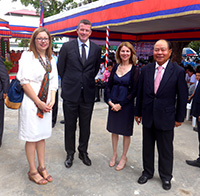◄ Back to Blood Service in Brief October 2016
The Cambodian Blood Safety Project is part of a US Presidents Emergency Program for AIDS Relief (PEPFAR) grant to strengthen the blood services in Cambodia and is administered by the US Centers for Disease Control and Prevention (CDC).Page Content After almost three years of planning, the Blood Service and Australian Red Cross, along with key international partners including PEPFAR, CDC, American International Health Alliance and US Pacific Command, has helped design, move and validate three new blood centre facilities in Cambodia.
The state-of-the-art buildings in Kampong Cham, Siem Reap and Phnom Penh, which opened in February, March and June 2016 respectively, will be used as both donor centres and processing sites. They represent significant progress in helping Cambodia provide the safest and most sustainable blood supply possible.
The Blood Service project provided design input for the buildings as well as developing the technical and management capacity of the Cambodian Blood Service by training them across all functional areas to help them gain full accreditation.
Reflecting on the day the facility opened in Phnom Penh, Emily Tonks, program manager from the Blood Service’s International Services team, recalls the “electric atmosphere”.
“Attending the opening was simply an amazing experience,” she said. “It was buzzing with excitement. The culmination of years of work by numerous partners, who all support the blood service in Cambodia — it was great to see it all come together, and really satisfying to know that they have this incredible facility from which to run their blood program in years to come.
“I’m so proud of the Blood Service’s involvement in programs like this. Not only do they provide great professional development opportunities for staff, but the chance to leverage the existing skills and knowledge we have in the Blood Service for humanitarian activities, too. We’re actively contributing to improving patient outcomes in other countries through safe blood and good clinical practice. That’s pretty awesome!”
This article was supported by the Cooperative Agreement Number 1U2GGH000861 from the Centers for Disease Control and Prevention. Its contents are solely the responsibility of the authors and do not necessarily represent the official views of the Centers for Disease Control and Prevention.
Photo: Emily Tonks (Blood Service), Peter Walton (Australian Red Cross) and Sally Thomas (Blood Service) with the Cambodian Minister for Health.

